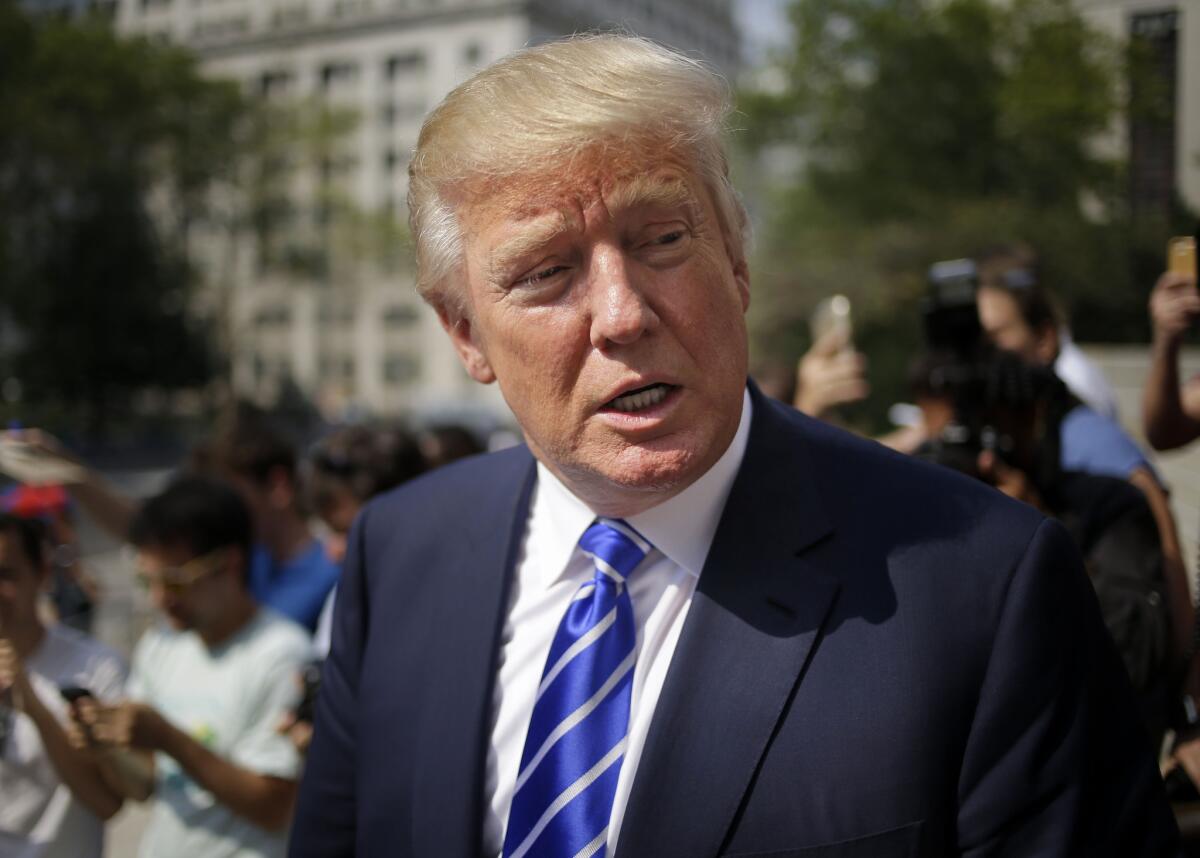Trump plan: Make immigrants pay for ‘permanent border wall’ and deport millions

Republican presidential candidate Donald Trump has outlined a plan to fix the immigration system.
Reporting from Washington — Donald Trump has been stirring up passions with his heated rhetoric on immigration for weeks. But when he finally outlined a platform Sunday detailing his policy proposals, what he outlined wasn’t all red meat. The plan, as he posted on his website and explained in an interview on NBC’s “Meet the Press,” offers a mix of familiar conservative proposals, alongside some far-fetched ideas and blunt talk that pleased immigration hard-liners. It’s likely to lay down the marker for his rivals as they roll out their own.
A breakdown of what Trump says he’d do to fix the nation’s immigration system:
Build a wall:
“There must be a wall across the southern border,” is the first core principle of Trump’s plan. A “permanent border wall,” he argues, would stem illegal crossings and cut down on crimes committed in the U.S. by people in the country illegally. In this, Trump is treading on familiar ground. Many Republican politicians have at times argued for building a wall between the U.S. and Mexico, as a way of one-upping the high-tech fence already in place across much of the border.
But Trump’s proposal veers from the script in that it proposes forcing Mexico to pay for construction of the wall – or, more precisely, forcing Mexican immigrants to pay for the wall. Trump would cover the cost by seizing remittances that immigrants send back to families in Mexico if the money was “derived from illegal wages.” He also would raise the cost of legal immigration to the U.S. by raising fees on various worker and diplomatic visas.
TRAIL GUIDE: All the latest news on the 2016 presidential campaign >>
Mexicans living abroad sent $23.6 billion in remittances in 2014, most of that from the U.S. It was not clear how Trump planned to determine what share of that came from “illegal wages” and how he would “impound it.”
“Remittances are a big part of workers’ lives, especially lower-skilled workers and a lot of families in Mexico rely on them. It’s big business; it’s billions of dollars,” said Audrey Singer, a senior fellow at the Brookings Metropolitan Policy Program. “It’s not easily measured and it’s not easily regulated. Enforcing something like that would be nearly impossible.”
Birthright citizenship:
Trump proposed ending what’s known as birthright citizenship, U.S. law that grants citizenship to babies born in the U.S. regardless of their parents’ legal status. Trump and many conservatives argue that the law encourages immigrants to enter the U.S. illegally to give birth, an analysis many experts argue ignores that economic opportunity is the primary incentive for immigrants.
The push to end birthright citizenship has gained steam in recent years. Although many believe changing it requires a constitutional amendment, Rep. Steve King (R-Iowa) has proposed legislation to change the law. King’s Birthright Citizenship Act of 2013 had 39 cosponsors in the House, and a related bill introduced by Sen. David Vitter (R-La.) had two cosponsors in the Senate.
Trump’s plan ensured the proposal would remain a part of the ongoing debate over immigration. On Monday, Wisconsin Gov. Scott Walker told MSNBC that he agreed that the U.S. should end birthright citizenship. An aide for Democratic front-runner Hillary Rodham Clinton accused Walker and Trump of taking “extreme anti-immigrant positions.”
Deporting the 11 million immigrants already in the U.S.:
Trump’s plan outlines several policies he says would crack down on illegal immigration and tighten enforcement of immigration law, but it does not detail what he would do with immigrants already living in the U.S. illegally.
On “Meet the Press,” Trump suggested he would deport them. “We’re going to keep the families together ... but they have to go,” he said. Trump’s position is not often articulated by those who argue against creating a path to legal status for immigrants already here. A program for mass deportation would probably be expensive, logistically difficult and unpopular with the public.
Hire Americans first:
Trump’s proposal would increase the prevailing wage for H-1B visa holders and freeze green cards issued to foreign workers -- ideas he says would force U.S. companies to hire American workers instead of importing immigrant labor. The plan is notable in that it argues that immigrant labor is to blame for the erosion of middle-class wages, a line of argument that tends to blame immigrants for Americans’ economic woes.
“The influx of foreign workers holds down salaries, keeps unemployment high, and makes it difficult for poor and working-class Americans – including immigrants themselves and their children – to earn a middle-class wage,” it reads.
This element of the plan won kudos from those pushing the candidates to begin talking about not just curbing illegal immigration, but cutting back on legal immigration. That is “a jobs and wage issue,” said Roy Beck of NumbersUSA.
“The most important outcome of Trump’s plans may be pressure for all candidates – including Trump – to be asked what level of legal immigration they support,” Beck said.
But it’s part of what worries some Mexicans about the rise of anti-immigrant rhetoric.
“I have family in the U.S. and they are very worried about what this man says. They make an honest living and don’t deserve to be called criminals,” said Maria Espinoza Lopez, 45, a secretary in Mexico City.
Times researcher Cecilia Sanchez in Mexico City contributed to this report.
For more presidential campaign coverage, follow @khennessey
ALSO:
Hunt continues for bear that attacked man near Yosemite
Overcharged DWP customers to get tens of millions back
Grim Sleeper serial killings: Repeatedly delayed trial is set for Oct. 14
More to Read
Sign up for Essential California
The most important California stories and recommendations in your inbox every morning.
You may occasionally receive promotional content from the Los Angeles Times.











